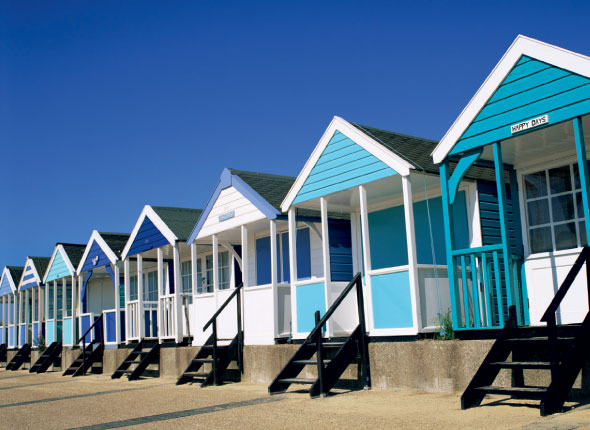By the sea, by the beautiful sea
So what's it really like to own a beach hut? Along the coast in Sussex, Gladys Brown has been living the dream since she was barely bigger than a pebble, and now, at 83 years old, she is somewhat of an expert. Gladys has an 8ft by 6ft white wooden hut on the foreshore lined up with 285 other privately owned beach huts at Goring-by-Sea. Every morning, from the beginning of spring, Gladys and her fellow hutters decamp to the beach and don't put up the shutters again till late autumn, thereby following a quintessentially English tradition that started in the early 18th century, with the invention of bathing machines by a Margate Quaker named Benjamin Beale.

In 1793, George III took the first royal splash from one of these contraptions, and his son, the Prince of Wales, became so hooked on bathing, he had the Royal Pavilion at Brighton built so he could indulge every day. The bathing machine looked like a beach hut on wheels, with a door and steps for access. It enabled aristocrats to bathe without fear of proto-paparazzi sneaking up on them. They would undress in the hut while a horse pulled it down to the beach and into the sea until the floor was just above the waves. When the horse stopped, the bather would slip out for a modest dip. It was an elaborate business involving wearing copious amounts of clothing and being led into the sea by a 'dipper', a strong person of the same sex who would help the bather in and out of the sea.
 Thankfully, things loosened up a little. By Victorian times one could be on the same beach at the same time as a member of the opposite sex without a horse and cart. This was due in part to middle-class people travelling to Dieppe and Boulogne in search of fun and discovering the firmly rooted hut that Gladys and her friends enjoy today.
Thankfully, things loosened up a little. By Victorian times one could be on the same beach at the same time as a member of the opposite sex without a horse and cart. This was due in part to middle-class people travelling to Dieppe and Boulogne in search of fun and discovering the firmly rooted hut that Gladys and her friends enjoy today.
The excitement of the beach hut is in part due to the domestic comforts it affords the user. Inside Gladys's hut, for instance, are all the accoutrements needed for a scene from a Merchant Ivory production. She has recently installed a new carpet and is keen to point out that teamaking facilities are available all day. There is a collection of pre-war flip-flops and swimming costumes for the occasional visitor caught short. 'We're not worried about fashion down here,' she says.
But hut interiors can generate stiff competition. 'One of my friends has her best china in there and is constantly painting the inside,' she says. 'All she needs is a front door knocker and she could live in there. Some people can get too carried away.

'Having the hut means you can be on the beach all day and let the family get on with things while you keep a quiet eye,' Gladys continues. And there have been unexpected bonuses, as her late husband, Henry, discovered. 'One summer we were on the beach and he was swimming. When he came out of the water the tide had been so strong, his false teeth had been yanked out. He was distraught, as you can imagine. Then, five hours later, I was sitting outside the hut having a cup of tea and what should I notice being washed up on to the shore? His teeth! I don't know where they'd been, but we certainly wouldn't have found them again if we hadn't had the hut.'
There are endless possibilities for the designer age in these strange constructions. Imagine a Philippe Starck hut or an Ikea self-assembly version. Surely it can only be a matter of time before owning a private beach hut on the south coast becomes as impressive as a private box at Wimbledon or a house in the same street as Madonna. And now that sun tans are verboten, the lack of UV rays should be a positive asset. As for beach culture, Gladys has this to offer: 'When my son Brian was a boy, he used to love it at the hut. It meant he could stare at the nudist bathers through his binoculars!' Who needs Baywatch?



